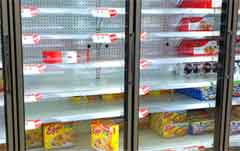| |
|
| |
|
 |
Supply
Chain by the Numbers |
| |
|
| |
- July 13, 2017 -
|
| |
|
| |
|
| |
|
| |
Walmart Tightening Screws on Vendors Again; Consolidation Continues in the Container Shipping Sector; UPS Forced to Pay Weekly Retention Bonuses at Hub; Amazon Market Share Continues to Grow |
| |
|
| |
| |
| |
3% |
 |
| That is the new penalty, often called a retail chargeback, on the value of goods shipped by vendors Walmart which arrive late or are incomplete, according to a report this week from Bloomberg. That also comes with tightened requirements for deliveries, which now must hit a 95% threshold for being on-time and in-full (so-called OTIF), under a Walmart program of that name. The report, based on a Bloomberg review of a powerpoint presentation Walmart recently shared with vendors, is actually a little confusing and in some places contradictory, but SCDigest believes is directionally accurate, as Walmart continues to try to drive vendor performance to improve financial results and compete with Amazon. Walmart says in the presentation that the new rules should drive $1 billion in additional sales for the company by improving in-stock positions. The new rules begin in August, and the company said they will require full-truckload suppliers of fast-turning items -- groceries, paper towels - to "deliver what we ordered 100% in full, on the must-arrive-by date 75% of the time." Items that are late or missing during a one-month period will incur a fine of 3% of their value. Early shipments get dinged, too, because they create overstocks. "Variability is the No. 1 killer of the supply chain," Kendall Trainor, a Walmart manager, said in a presentation to vendors earlier this year. |

|
|
| |
| |
|
|
|
Amazingly, that is the weekly retention bonus now being offered to some UPS package handlers hired in 2017. Workers can receive the weekly bonus if they were hired this year to work in UPS's Second-Day Air operation in Louisville or hired after March 13 to work in the company's Ohio Valley District ground operation. The bonus increases to $200 this fall and will also apply to workers hired on or after Oct. 1 to work in the UPS Next-Day Air operation. Eligible employees must work each scheduled day in a given week to receive that week’s bonus. The many distribution companies in the Louisville area face strong competition in finding and keeping workers, especially during the busy holiday period. Just recently, Radial Inc., a Pennsylvania-based ecommerce company, said it plans to hire an additional 3,750 workers to handle the holiday rush at its fulfillment centers in Louisville and nearby Shepherdsville. It also plans to hire 4,100 additional workers for its two fulfillment centers in Northern Kentucky. It's simply supply and demand - and good money for UPS workers, which must in the end put pressure on rates. |
| |
| |
|
| |
| |
5% |
|
That is the share of US retail sales now enjoyed by Amazon in the segments that it serves, which for the moment does not include groceries. That according to new analysis from MKM Partners, a stock market research firm. That share has about doubled from the roughly 2.5% share Amazon held in Q3 2014. The growth of Amazon's share of retail revenues comes as "same store" sales for traditional brick and mortar retailers continues to fall, approaching zero or negative growth recently. The median growth for what MKM Partners calls the top-20 U.S. retailers was 2.4% in the fourth quarter of 2016, 0.8% during the first quarter of 2017, and is forecast to decline by 0.2% in the second quarter this year, the firm said. MKM also predicts that Amazon's share of retail sales across the US in key categories - sporting goods, clothing, personal care and electronics - will only continue to accelerate from current levels. Amazon, essentially, is "eating the retail world," MKM Partners analyst Rob Sanderson wrote in a research note last week. He added that "This [trend] does not end well for traditional retailers and many will go the way of Borders and Circuit City, leaders in the first two large categories disrupted by Amazon.com." |
| |
| |
|
|
|
| |
 |
 |
| |
|
|
| |